HP C2L36UA, C2M17UA, DV6-7258NR, C7S02UA, DV6 User Manual
User Guide
© Copyright 2012 Hewlett-Packard
Development Company, L.P.
Bluetooth is a trademark owned by its proprietor and used by Hewlett-Packard Company under license. Intel is a trademark of Intel Corporation in the U.S. and other countries. Microsoft and Windows are U.S. registered trademarks of Microsoft Corporation. SD Logo is a trademark of its proprietor.
The information contained herein is subject to change without notice. The only warranties for HP products and services are set forth in the express warranty statements accompanying such products and services. Nothing herein should be construed as constituting an additional warranty. HP shall not be liable for technical or editorial errors or omissions contained herein.
First Edition: September 2012
Document Part Number: 692789-001
Product notice
This guide describes features that are common to most models. Some features may not be available on your computer.
Software terms
By installing, copying, downloading, or otherwise using any software product preinstalled on this computer, you agree to be bound by the terms of the HP End User License Agreement (EULA). If you do not accept these license terms, your sole remedy is to return the entire unused product (hardware and software) within 14 days for a refund subject to the refund policy of your place of purchase.
For any further information or to request a full refund of the computer, please contact your local point of sale (the seller).

Safety warning notice
WARNING! To reduce the possibility of heat-related injuries or of overheating the computer, do not place the computer directly on your lap or obstruct the computer air vents. Use the computer only on a hard, flat surface. Do not allow another hard surface, such as an adjoining optional printer, or a soft surface, such as pillows or rugs or clothing, to block airflow. Also, do not allow the AC adapter to come into contact with the skin or a soft surface, such as pillows or rugs or clothing, during operation. The computer and the AC adapter comply with the user-accessible surface temperature limits defined by the International Standard for Safety of Information Technology Equipment (IEC 60950).
iii
iv Safety warning notice

Table of contents
1 Starting right ................................................................................................................................................... |
1 |
Best practices ....................................................................................................................................... |
1 |
Fun things to do .................................................................................................................................... |
2 |
More HP resources .............................................................................................................................. |
3 |
2 Getting to know your computer ..................................................................................................................... |
4 |
Finding your hardware and software information ................................................................................. |
4 |
Locating hardware ............................................................................................................... |
4 |
Locating software ................................................................................................................. |
4 |
Front ..................................................................................................................................................... |
4 |
Right side ............................................................................................................................................. |
5 |
Left side ................................................................................................................................................ |
7 |
Rear ...................................................................................................................................................... |
8 |
Display .................................................................................................................................................. |
9 |
Top ..................................................................................................................................................... |
10 |
TouchPad .......................................................................................................................... |
10 |
Lights ................................................................................................................................. |
11 |
Buttons, speakers, and fingerprint reader .......................................................................... |
12 |
Keys ................................................................................................................................... |
13 |
Bottom ................................................................................................................................................ |
15 |
Labels ................................................................................................................................................. |
16 |
3 Connecting to a network .............................................................................................................................. |
17 |
Connecting to a wireless network ....................................................................................................... |
17 |
Using the wireless controls ................................................................................................ |
17 |
Using the wireless button .................................................................................. |
17 |
Using operating system controls ....................................................................... |
18 |
Using a WLAN ................................................................................................................... |
18 |
Using an Internet service provider .................................................................... |
18 |
Setting up a WLAN ............................................................................................ |
19 |
Configuring a wireless router ............................................................................ |
19 |
v
Protecting your WLAN ....................................................................................... |
19 |
Connecting to a WLAN ...................................................................................... |
20 |
Using Bluetooth wireless devices (select models only) ..................................................... |
20 |
Connecting to a wired network ........................................................................................................... |
21 |
Connecting to a local area network (LAN) ......................................................................... |
21 |
4 Enjoying entertainment features ................................................................................................................. |
22 |
Using the webcam .............................................................................................................................. |
23 |
Using audio ........................................................................................................................................ |
24 |
Connecting speakers ......................................................................................................... |
24 |
Connecting headphones .................................................................................................... |
24 |
Connecting a microphone .................................................................................................. |
24 |
Using Beats Audio ............................................................................................................. |
24 |
Accessing Beats Audio Control Panel ............................................................... |
24 |
Enabling and Disabling Beats Audio ................................................................. |
24 |
Checking the sound ........................................................................................................... |
25 |
Using video ......................................................................................................................................... |
25 |
Connecting a VGA monitor or projector ............................................................................. |
26 |
Connecting an HDMI device .............................................................................................. |
27 |
Configuring audio settings (with HDMI TV) ....................................................... |
28 |
Using Intel Wireless Display (select models only) ............................................................. |
28 |
Managing your audio and video files .................................................................................................. |
28 |
5 Navigating using touch gestures, pointing devices and the keyboard ................................................... |
29 |
Using the TouchPad ........................................................................................................................... |
30 |
Using TouchPad gestures .................................................................................................................. |
31 |
Tapping .............................................................................................................................. |
31 |
Scrolling ............................................................................................................................. |
32 |
Pinching/zooming .............................................................................................................. |
32 |
Rotating (select models only) ............................................................................................ |
33 |
2-finger click (select models only) ...................................................................................... |
33 |
Flicking (select models only) .............................................................................................. |
34 |
Edge swipes ...................................................................................................................... |
34 |
Right-edge swipe .............................................................................................. |
34 |
Top-edge swipe ................................................................................................. |
35 |
Left-edge swipe ................................................................................................. |
35 |
Using the keyboard and mouse .......................................................................................................... |
36 |
Using the keys ................................................................................................................... |
36 |
Using the action keys ........................................................................................ |
36 |
Using Microsoft Windows 8 shortcut keys ......................................................... |
37 |
Using the hot keys ............................................................................................. |
38 |
vi
Using the integrated numeric keypad ................................................................................ |
38 |
6 Managing power ............................................................................................................................................ |
39 |
Initiating Sleep and Hibernation ......................................................................................................... |
40 |
Intel Rapid Start Technology (select models only) ............................................................ |
40 |
Initiating and exiting Sleep ................................................................................................. |
40 |
Enabling and exiting user-initiated hibernation .................................................................. |
41 |
Setting password protection on wakeup ............................................................................ |
41 |
Using the power meter and power settings ........................................................................................ |
42 |
Selecting a power plan ....................................................................................................................... |
43 |
Running on battery power .................................................................................................................. |
44 |
Factory-sealed battery ....................................................................................................... |
44 |
Removing a user-replaceable battery ................................................................................ |
44 |
Finding battery information ................................................................................................ |
44 |
Conserving battery power .................................................................................................. |
45 |
Identifying low battery levels .............................................................................................. |
45 |
Resolving a low battery level ............................................................................................. |
45 |
Resolving a low battery level when external power is available ........................ |
45 |
Resolving a low battery level when no power source is available ..................... |
46 |
Resolving a low battery level when the computer cannot exit Hibernation ....... |
46 |
Storing a user-replaceable battery ..................................................................................... |
46 |
Disposing of a user-replaceable battery ............................................................................ |
46 |
Replacing a user-replaceable battery ................................................................................ |
46 |
Running on external AC power .......................................................................................................... |
46 |
Troubleshooting power problems ...................................................................................... |
47 |
HP CoolSense (select models only) ................................................................................................... |
48 |
Refreshing your software content with Intel Smart Connect Technology (select models only) .......... |
49 |
Shutting down (turning off) the computer ........................................................................................... |
50 |
7 Managing and sharing information ............................................................................................................. |
51 |
Using a USB device ........................................................................................................................... |
51 |
Connecting a USB device .................................................................................................. |
51 |
Removing a USB device .................................................................................................... |
52 |
Connecting a powered USB device ................................................................................... |
52 |
Inserting and removing a digital storage card .................................................................................... |
53 |
Using optical drives ............................................................................................................................ |
54 |
Inserting an optical disc ..................................................................................................... |
55 |
Removing an optical disc ................................................................................................... |
56 |
Sharing data and drives and accessing software .............................................................. |
57 |
vii
8 Maintaining your computer .......................................................................................................................... |
58 |
Improving performance ...................................................................................................................... |
58 |
Handling drives .................................................................................................................. |
58 |
Replacing a hard drive ....................................................................................................... |
59 |
Using HP 3D DriveGuard (select models only) .................................................................. |
61 |
Using Disk Defragmenter ................................................................................................... |
61 |
Using Disk Cleanup ........................................................................................................... |
61 |
Adding or replacing memory modules ............................................................................... |
62 |
Updating programs and drivers .......................................................................................................... |
65 |
Cleaning your computer ..................................................................................................................... |
65 |
Cleaning the display, sides, and cover .............................................................................. |
65 |
Cleaning the TouchPad and keyboard .............................................................................. |
65 |
Traveling with or shipping your computer ........................................................................................... |
66 |
9 Securing your computer and information .................................................................................................. |
67 |
Using passwords ................................................................................................................................ |
68 |
Setting Windows passwords .............................................................................................. |
68 |
Setting Setup Utility (BIOS) passwords ............................................................................. |
69 |
Using the fingerprint reader ................................................................................................................ |
69 |
Using HP SimplePass (select models only) ....................................................................... |
70 |
Registering fingerprints ..................................................................................... |
70 |
Setting up Windows logon ................................................................................. |
70 |
Using your registered fingerprint to log on to Windows ..................................... |
70 |
Using Internet security software ......................................................................................................... |
71 |
Using antivirus software ..................................................................................................... |
71 |
Using firewall software ....................................................................................................... |
71 |
Installing software updates ................................................................................................................. |
72 |
Installing Windows updates ............................................................................................... |
72 |
Installing HP and third-party software updates .................................................................. |
72 |
Securing your wireless network .......................................................................................................... |
72 |
Backing up your software apps and information ................................................................................ |
72 |
Using an optional security cable lock ................................................................................................. |
73 |
10 Using Setup Utility (BIOS) and System Diagnostics ............................................................................... |
74 |
Starting Setup Utility (BIOS) ............................................................................................................... |
74 |
Updating the BIOS ............................................................................................................................. |
74 |
Determining the BIOS version ........................................................................................... |
74 |
Downloading a BIOS update ............................................................................................. |
75 |
Using System Diagnostics .................................................................................................................. |
76 |
viii
11 Backing up, restoring, and recovering ..................................................................................................... |
77 |
|
|
Creating recovery media and backups ............................................................................................... |
78 |
|
Creating HP Recovery media ............................................................................................ |
79 |
|
Restore and recovery ......................................................................................................................... |
80 |
|
Using Windows Refresh for quick and easy recovery ....................................................... |
81 |
|
Remove everything and reinstall Windows ........................................................................ |
81 |
|
Recovering using HP Recovery Manager .......................................................................... |
82 |
|
What you need to know ..................................................................................... |
82 |
|
Using the HP Recovery partition to recover a minimized image (select |
|
|
models only) ...................................................................................................... |
83 |
|
Using HP Recovery media to recover ............................................................... |
83 |
|
Changing the computer boot order ................................................................... |
84 |
|
Removing the HP Recovery partition ................................................................................. |
84 |
12 |
Specifications .............................................................................................................................................. |
85 |
|
Input power ......................................................................................................................................... |
85 |
|
Operating environment ....................................................................................................................... |
86 |
13 |
Electrostatic Discharge .............................................................................................................................. |
87 |
Index ................................................................................................................................................................... |
88 |
|
ix
x

1 Starting right
This computer is a powerful tool designed to enhance your work and entertainment. To get the most out of your computer, read this chapter to learn about best practices after setup, fun things to do with your computer, and where to go to get more HP resources.
Best practices
To get the most out of your smart investment, after you set up and register the computer, we recommend the following steps:
●If you haven’t already done so, connect to a wired or wireless network. See details in Connecting to a network on page 17.
●Take a minute to browse the printed Windows 8 Basics guide to explore your new Windows® features.

 TIP: To quickly return to the computer Start screen from an open app or the desktop, press the Windows logo key
TIP: To quickly return to the computer Start screen from an open app or the desktop, press the Windows logo key  on your keyboard. Pressing the Windows logo key again will return you to the previous screen.
on your keyboard. Pressing the Windows logo key again will return you to the previous screen.
●Become familiar with the computer hardware and software. Go to Getting to know your computer on page 4 and Enjoying entertainment features on page 22 for information.
●Update or purchase antivirus software. Learn more at Using antivirus software on page 71.
●Back up your hard drive by creating recovery discs or a recovery flash drive. See Backing up, restoring, and recovering on page 77.
Best practices |
1 |
Fun things to do
●You know you can watch a YouTube video on the computer. But did you know that you can also connect your computer to a TV or gaming console? For more information, see Connecting an HDMI device on page 27.
●You know you can listen to music on the computer. But did you know that you can also stream live radio to the computer and listen to music or talk radio from all over the world? See Using audio on page 24.
●You know you can create a powerful presentation with Microsoft apps. But did you know you can also connect to a projector to share your ideas with a group? See Connecting a VGA monitor or projector on page 26.
●Experience music the way the artist intended, with deep controlled base and clear, pure sound. See Using Beats Audio on page 24.
●Use the TouchPad and the new Windows 8 touch gestures for smooth control of images and pages of text. See Using TouchPad gestures on page 31.
2 Chapter 1 Starting right

More HP resources
You have already used Setup Instructions to turn on the computer and locate this guide. For product details, how-to information, and more, use this table.
Resource |
Contents |
|
|
|
|
Setup Instructions |
● Overview of computer setup and features. |
|
|
|
|
Windows 8 Basics guide |
● Overview of using and navigating with Windows® 8. |
|
|
|
|
Help and Support |
● A broad range of how-to information and troubleshooting tips. |
|
To access Help and Support, from the Start screen, |
|
|
type h, and then select Help and Support. For U.S. |
|
|
support, go to http://www.hp.com/go/contactHP. For |
|
|
worldwide support, go to http://welcome.hp.com/ |
|
|
country/us/en/wwcontact_us.html. |
|
|
|
|
|
Safety & Comfort Guide |
● |
Proper workstation setup. |
To access this guide, select HP Support Assistant |
● Guidelines for posture and work habits that increase your |
|
app on the Start screen, select My computer, and |
|
comfort and decrease your risk of injury. |
then select User guides, or go to http://www.hp.com/ |
● Electrical and mechanical safety information. |
|
ergo. |
||
|
|
|
Worldwide support |
● Chat online with an HP technician. |
|
To get support in your language, go to |
● |
Email support. |
http://welcome.hp.com/country/us/en/ |
● Find support telephone numbers. |
|
wwcontact_us.html. |
||
|
● Locate HP service center locations. |
|
|
|
|
Regulatory, Safety and Environmental Notices |
● Important regulatory notices, including proper battery disposal |
|
To access this guide, select the HP Support |
|
information. |
|
|
|
Assistant app on the Start screen, select My |
|
|
computer, and then select User guides. |
|
|
|
|
|
Limited Warranty* |
● Specific warranty information about this computer. |
|
To access this guide, select the HP Support |
|
|
Assistant app on the Start screen, select My |
|
|
computer, and then select Warranty and services, or go to http://www.hp.com/go/orderdocuments.
*You can find the expressly provided HP Limited Warranty applicable to your product located with the user guides on your computer and/or on the CD/DVD provided in the box. In some countries/regions, HP may provide a printed HP Limited Warranty in the box. For countries/regions where the warranty is not provided in printed format, you may request a printed copy from http://www.hp.com/go/orderdocuments or write to:
●North America: Hewlett-Packard, MS POD, 11311 Chinden Blvd., Boise, ID 83714, USA
●Europe, Middle East, Africa: Hewlett-Packard, POD, Via G. Di Vittorio, 9, 20063, Cernusco s/Naviglio (MI), Italy
●Asia Pacific: Hewlett-Packard, POD, P.O. Box 200, Alexandra Post Office, Singapore 911507
When you request a printed copy of your warranty, please include your product number, warranty period (found on your service label), name, and postal address.
IMPORTANT: Do NOT return your HP product to the addresses above. For U.S. support, go to http://www.hp.com/go/ contactHP. For worldwide support, go to http://welcome.hp.com/country/us/en/wwcontact_us.html.
More HP resources 3
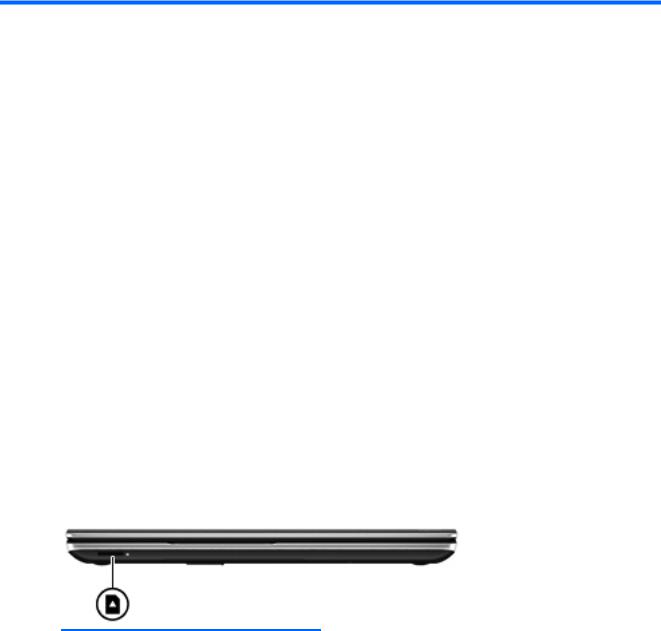
2 Getting to know your computer
Finding your hardware and software information
Locating hardware
To find out what hardware is installed on your computer:
1.From the Start screen, type c, and then select Control Panel.
2.Select System and Security, and then in the System area, click Device Manager. A list displays all the devices installed in your computer.
Locating software
▲To find out what software is installed on your computer, from the Start screen, right-click using the mouse or swipe from the top of the TouchPad to display the Apps, and then select the All apps icon.
Front
Component |
Description |
|
|
Digital Media Slot |
Supports the following digital card formats: |
|
● Secure Digital (SD) Memory Card |
|
● Secure Digital High Capacity (SDHC) Memory Card |
|
● Secure Digital Extended Capacity (SDxC) Memory Card |
|
● Ultra High Speed MultiMediaCard (UHS/MMC) |
|
|
4 |
Chapter 2 Getting to know your computer |
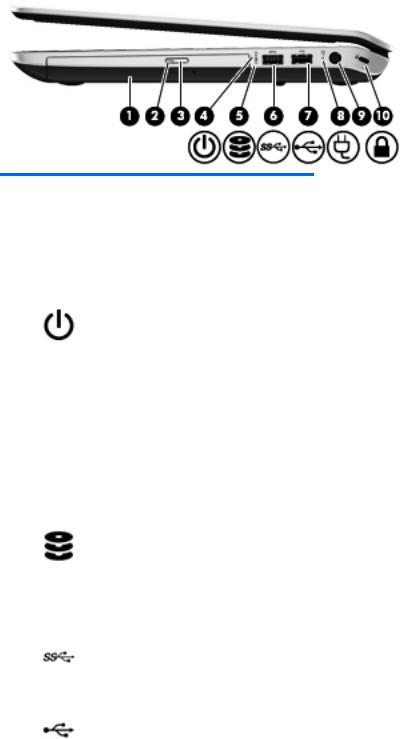
Right side
Component |
|
Description |
|
|
|
(1) |
Optical drive |
Reads and writes (select models only) to an optical disc. |
|
|
|
(2) |
Optical drive light |
● Green: The optical drive is being accessed. |
|
|
● Off: The optical drive is idle. |
|
|
|
(3) |
Optical drive eject button |
Releases the disc tray. |
|
|
|
(4) |
Power light |
● White: The computer is on. |
|
|
● Blinking white: The computer is in the Sleep state, |
|
|
which is an energy-saving mode. The computer |
|
|
shuts off power to the display and other unneeded |
|
|
components. |
|
|
● Off: The computer is off or in Hibernation. |
|
|
Hibernation is an energy-saving mode that uses the |
|
|
least amount of power. |
|
|
NOTE: For select models, the Intel® Rapid Start |
|
|
Technology feature is enabled at the factory. Rapid |
|
|
Start Technology allows your computer to resume |
|
|
quickly from inactivity. For more information, see |
|
|
Initiating Sleep and Hibernation on page 40. |
|
|
|
(5) |
Hard drive light |
● Blinking white: The hard drive is being accessed. |
|
|
● Amber: HP 3D DriveGuard has temporarily parked |
|
|
the hard drive. |
|
|
NOTE: For information about HP 3D DriveGuard, |
|
|
see Using HP 3D DriveGuard (select models only) |
|
|
on page 61. |
|
|
|
(6) |
USB 3.0 port |
Connects an optional USB 3.0 device and provides |
|
|
enhanced USB power performance. |
|
|
NOTE: For details about different types of USB ports, |
|
|
see Using a USB device on page 51. |
|
|
|
(7) |
USB 2.0 port |
Connects an optional USB device. |
|
|
NOTE: For details about different types of USB ports, |
|
|
see Using a USB device on page 51. |
|
|
|
Right side |
5 |

Component |
|
Description |
|
|
|
(8) |
AC adapter light |
● White: The AC adapter is connected and the battery |
|
|
is charged. |
|
|
● Amber: The AC adapter is connected and the battery |
|
|
is charging. |
|
|
● Off: The computer is using DC power. |
|
|
|
(9) |
Power connector |
Connects an AC adapter. |
|
|
|
(10) |
Security cable slot |
Attaches an optional security cable to the computer. |
|
|
NOTE: The security cable is designed to act as a |
|
|
deterrent, but it may not prevent the computer from being |
|
|
mishandled or stolen. |
|
|
|
6 |
Chapter 2 Getting to know your computer |
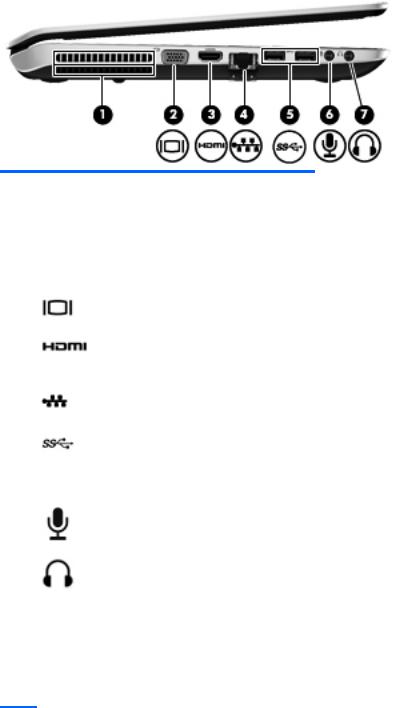
Left side
Component |
|
Description |
|
|
|
(1) |
Vent |
Enables airflow to cool internal components. |
|
|
NOTE: The computer fan starts up automatically to cool |
|
|
internal components and prevent overheating. It is normal |
|
|
for the internal fan to cycle on and off during routine |
|
|
operation. |
|
|
|
(2) |
External monitor port |
Connects an external VGA monitor or projector. |
|
|
|
(3) |
HDMI port |
Connects an optional video or audio device, such as a |
|
|
high-definition television, or any compatible digital or |
|
|
audio device. |
|
|
|
(4) |
RJ-45 (network) jack |
Connects a network cable. |
|
|
|
(5) |
USB 3.0 ports (2) |
Connect optional USB 3.0 devices and provide enhanced |
|
|
USB power performance. |
|
|
NOTE: For details about different types of USB ports, |
|
|
see Using a USB device on page 51. |
|
|
|
(6) |
Audio-in (microphone) jack |
Connects an optional computer headset microphone, |
|
|
stereo array microphone, or monaural microphone. |
|
|
|
(7) |
Audio-out (headphone) jack |
Connects optional powered stereo speakers, |
|
|
headphones, earbuds, a headset, or a television audio |
|
|
cable. |
WARNING! To reduce the risk of personal injury, adjust the volume before using headphones, earbuds, or a headset. For additional safety information, see the
Regulatory, Safety and Environmental Notices.
NOTE: When a device is connected to a headphone jack, the computer speakers are disabled.
Left side |
7 |

Rear
Component |
Description |
|
|
Vent |
Enables airflow to cool internal components. |
|
NOTE: The computer fan starts up automatically to cool internal |
|
components and prevent overheating. It is normal for the internal fan to cycle |
|
on and off during routine operation. |
|
|
8 |
Chapter 2 Getting to know your computer |
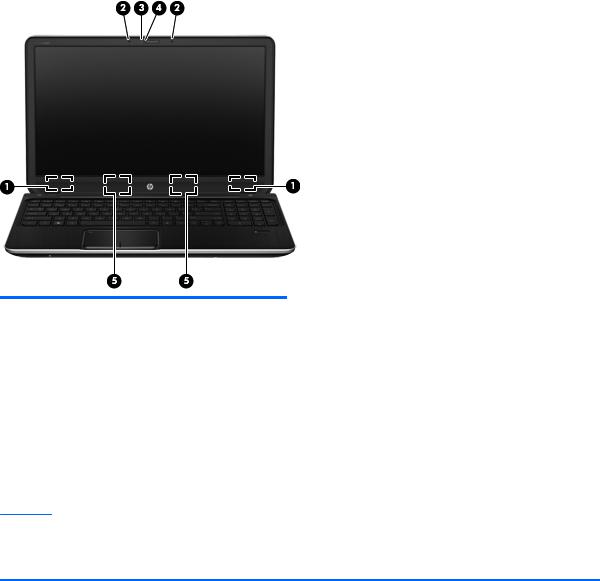
Display
Component |
Description |
|
|
|
|
(1) |
WLAN antennas (2)* |
Send and receive wireless signals to communicate with wireless |
|
|
local area networks (WLANs). |
|
|
|
(2) |
Internal microphones (2) |
Record sound. |
|
|
|
(3) |
HP TrueVision HD Webcam |
Records video, captures still photographs, allows video |
|
|
conferences and online chat by means of streaming video. |
|
|
To use the webcam, from the Start screen, type c, and then |
|
|
select CyberLink YouCam. |
|
|
|
(4) |
Webcam light |
On: The webcam is in use. |
|
|
|
(5) |
Speakers (2) |
Produce sound. |
*The antennas are not visible from the outside of the computer. For optimal transmission, keep the area immediately around the antennas free from obstructions. For wireless regulatory notices, see the section of the Regulatory, Safety, and Environmental Notices that applies to your country or region. To access this guide, select the HP Support Assistant app on the Start screen, select My computer, and then select User guides.
Display 9
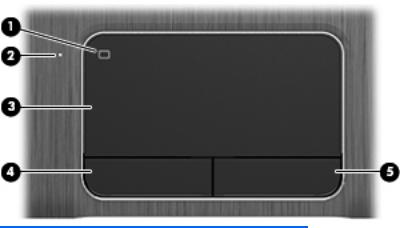
Top
TouchPad
Component |
|
Description |
|
|
|
(1) |
TouchPad on/off button |
Turns the TouchPad on or off. |
|
|
|
(2) |
TouchPad light |
● On: The TouchPad is off. |
|
|
● Off: The TouchPad is on. |
|
|
|
(3) |
TouchPad zone |
Moves the on-screen pointer and selects or activates items |
|
|
on the screen. |
|
|
|
(4) |
Left TouchPad button |
Functions like the left button on an external mouse. |
|
|
|
(5) |
Right TouchPad button |
Functions like the right button on an external mouse. |
|
|
|
10 Chapter 2 Getting to know your computer
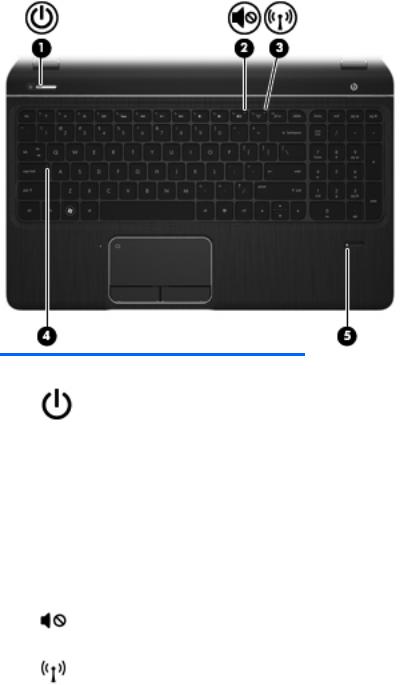
Lights
Component |
|
Description |
|
|
|
(1) |
Power light |
● White: The computer is on. |
|
|
● Blinking white: The computer is in the Sleep state, |
|
|
which is an energy-saving mode. The computer shuts |
|
|
off power to the display and other unneeded |
|
|
components. |
|
|
● Off: The computer is off or in Hibernation. Hibernation |
|
|
is an energy-saving mode that uses the least amount |
|
|
of power. |
|
|
NOTE: For select models, the Intel® Rapid Start |
|
|
Technology feature is enabled at the factory. Rapid |
|
|
Start Technology allows your computer to resume |
|
|
quickly from inactivity. For more information, see |
|
|
Initiating Sleep and Hibernation on page 40. |
|
|
|
(2) |
Mute light |
● Amber: Computer sound is off. |
|
|
● Off: Computer sound is on. |
|
|
|
(3) |
Wireless light |
● White: An integrated wireless device, such as a |
|
|
wireless local area network (WLAN) device and/or a |
|
|
Bluetooth® device, is on. |
|
|
● Amber: All wireless devices are off. |
|
|
|
(4) |
Caps lock light |
On: Caps lock is on, which switches the keys to all capital |
|
|
letters. |
|
|
|
(5) |
Fingerprint reader light |
● White: The fingerprint was read. |
|
|
● Amber: The fingerprint was not read. |
|
|
|
Top 11
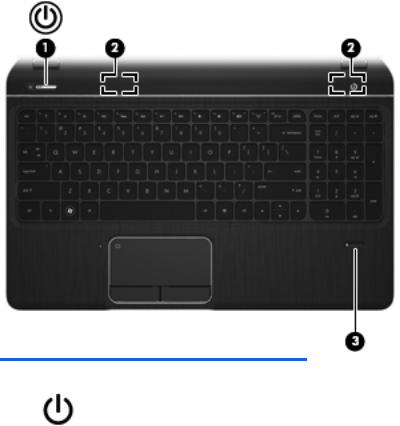
Buttons, speakers, and fingerprint reader
Component |
|
Description |
|
|
|
|
|
(1) |
Power button |
● When the computer is off, press the button to turn on |
|
|
|
|
the computer. |
|
|
● When the computer is in the Sleep state, press the |
|
|
|
|
button briefly to exit Sleep. |
|
|
CAUTION: Pressing and holding down the power button |
|
|
|
will result in the loss of unsaved information. |
|
|
|
If the computer has stopped responding and Microsoft® |
|
|
|
Windows® shutdown procedures are ineffective, press and |
|
|
|
hold down the power button for at least 5 seconds to turn |
|
|
|
off the computer. |
|
|
|
NOTE: For select models, the Intel® Rapid Start |
|
|
|
Technology feature is enabled at the factory. Rapid Start |
|
|
|
Technology allows your computer to resume quickly from |
|
|
|
inactivity. For more information, see Initiating Sleep and |
|
|
|
Hibernation on page 40. |
|
|
|
To learn more about your power settings: |
|
|
|
1. |
From the Start screen, type p. |
|
|
2. |
In the search box, type power. |
|
|
3. |
Select Settings, and then select Power options, or |
|
|
|
see Managing power on page 39. |
|
|
|
|
(2) |
Speakers (2) |
Produce sound. |
|
|
|
|
|
(3) |
Fingerprint reader |
Allows a fingerprint logon to Windows, instead of a |
|
|
|
password logon. |
|
|
|
|
|
12 Chapter 2 Getting to know your computer
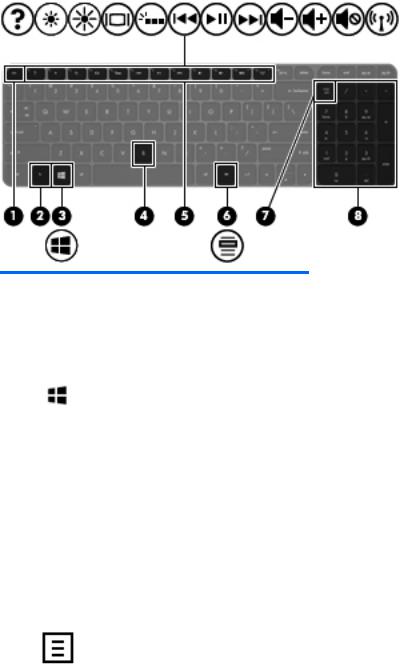
Keys
Component |
|
Description |
|
|
|
(1) |
esc key |
Displays system information when pressed in combination |
|
|
with the fn key. |
|
|
|
(2) |
fn key |
Executes frequently used system functions when pressed |
|
|
in combination with the b key, the spacebar, or the esc key. |
|
|
|
(3) |
Windows logo key |
Displays the Desktop or the Start screen. |
|
|
|
(4) |
b key |
Enables or disables Beats Audio when pressed in |
|
|
combination with the fn key. |
|
|
Beats Audio is an enhanced audio feature that provides a |
|
|
deep, controlled bass while maintaining a clear sound. |
|
|
Beats Audio is enabled by default. |
|
|
Opens Beats Audio Control Panel, which allows you to |
|
|
view and control all audio settings. |
|
|
NOTE: To open Beats Audio Control Panel, from Start |
|
|
screen, type c, select Control Panel, select Hardware and |
|
|
Sound, and then select Beats Audio Control Panel. |
|
|
|
(5) |
Action keys |
Execute frequently used system functions. |
|
|
|
(6) |
Windows apps key |
Displays options for a selected object. |
|
|
|
Top 13

Component |
|
Description |
|
|
|
(7) |
num lock key |
Controls the function of the integrated numeric keypad. |
|
|
Press the key to alternate between the standard numeric |
|
|
function of an external keypad (selected at the factory) and |
|
|
the navigational function (indicated by the directional |
|
|
arrows on the keys). |
|
|
NOTE: The keypad function that is active when the |
|
|
computer is turned off is reinstated when the computer is |
|
|
turned back on |
|
|
|
(8) |
Integrated numeric keypad |
Set at the factory to function like an external numeric |
|
|
keypad. To alternate between this numeric function and the |
|
|
navigational function (indicated by the directional arrows on |
|
|
the keys), press the num lock key. |
|
|
|
14 Chapter 2 Getting to know your computer
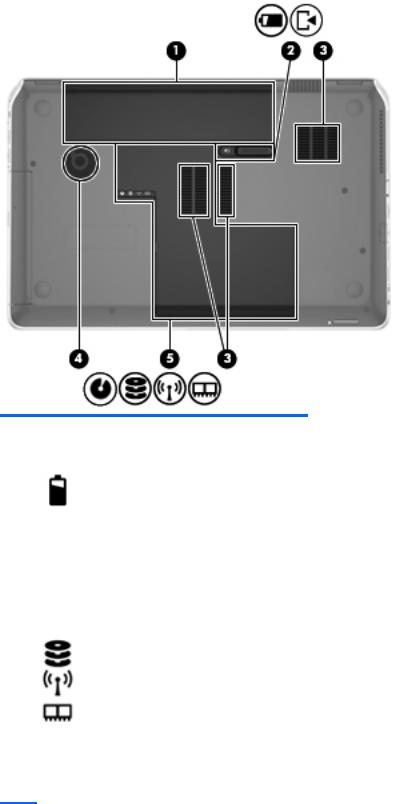
Bottom
Component |
|
Description |
|
|
|
(1) |
Battery bay |
Holds the battery. |
|
|
|
(2) |
Battery release latch |
Releases the battery from the battery bay and opens the |
|
|
service door. |
|
|
|
(3) |
Vents (3) |
Enable airflow to cool internal components. |
|
|
NOTE: The computer fan starts up automatically to cool |
|
|
internal components and prevent overheating. It is normal |
|
|
for the internal fan to cycle on and off during routine |
|
|
operation. |
|
|
|
(4) |
Integrated subwoofer |
Provides superior bass sound. |
|
|
|
(5) |
Hard drive bay, wireless compartment, and |
The service door provides access to the hard drive bay, |
|
memory module compartment |
wireless compartment and memory module compartment. |
CAUTION: To prevent an unresponsive system, replace the wireless module only with a wireless module authorized for use in the computer by the governmental agency that regulates wireless devices in your country or region. If you replace the module and then receive a warning message, remove the module to restore computer functionality, and then contact support through Help and Support. From the Start screen, type h, and then select Help and Support from the list of apps.
Bottom 15

Labels
The labels affixed to the computer provide information you may need when you troubleshoot system problems or travel internationally with the computer. The labels are in easily accessible locations.
●Service label—Provides important information, including the following:
Component
(1)Product name
(2)Serial number
(3)Product part number
(4)Warranty period
(5)Model description
Have this information available when you contact support. The service label is affixed inside the battery bay.
●Regulatory label—Provides regulatory information about the computer. The regulatory label is affixed inside the battery bay.
●Wireless certification label or labels—Provide information about optional wireless devices and the approval markings of some of the countries or regions in which the devices have been approved for use. If your computer model includes one or more wireless devices, one or more certification labels are included with your computer. You may need this information when traveling internationally. Wireless certification labels are affixed inside the battery bay.
16 Chapter 2 Getting to know your computer

3 Connecting to a network
Your computer can travel with you wherever you go. But even at home, you can explore the globe and access information from millions of websites using your computer and a wired or wireless network connection. This chapter will help you get connected to that world.
Connecting to a wireless network
Wireless technology transfers data across radio waves instead of wires. Your computer may be equipped with one or more of the following wireless devices:
●Wireless local area network (WLAN) device—Connects the computer to wireless local area networks (commonly referred to as Wi-Fi networks, wireless LANs, or WLANs) in corporate offices, your home, and public places such as airports, restaurants, coffee shops, hotels, and universities. In a WLAN, the mobile wireless device in your computer communicates with a wireless router or a wireless access point.
●Bluetooth device—Creates a personal area network (PAN) to connect to other Bluetoothenabled devices such as computers, phones, printers, headsets, speakers, and cameras. In a PAN, each device communicates directly with other devices, and devices must be relatively close together—typically within 10 meters (approximately 33 feet) of each other.
For more information about wireless technology, see the information and website links provided in Help and Support. From the Start screen, type h, and then select Help and Support from the list of apps.
Using the wireless controls
You can control the wireless devices in your computer using these features:
●Wireless button, wireless switch, or wireless key (referred to in this chapter as the wireless button)
●Operating system controls
Using the wireless button
The computer has a wireless button, one or more wireless devices, and one or two wireless lights, depending on the model. All of the wireless devices on your computer are enabled at the factory, so the wireless light is on (white) when you turn on the computer.
The wireless light indicates the overall power state of your wireless devices, not the status of individual devices. If the wireless light is white, at least one wireless device is on. If the wireless light is off, all wireless devices are off.
Connecting to a wireless network 17

 NOTE: On some models, the wireless light is amber when all wireless devices are off.
NOTE: On some models, the wireless light is amber when all wireless devices are off.
Because the wireless devices are enabled at the factory, you can use the wireless button to turn on or turn off the wireless devices simultaneously.
Using operating system controls
The Network and Sharing Center allows you to set up a connection or network, connect to a network, manage wireless networks, and diagnose and repair network problems.
To use operating system controls:
1.From the Start screen, type n, and then select Settings.
2.Type network and sharing in the search box, and then select Network and Sharing Center.
For more information, from the Start screen, type h, and then select Help and Support from the list of apps.
Using a WLAN
With a WLAN device, you can access a wireless local area network (WLAN), which is composed of other computers and accessories that are linked by a wireless router or a wireless access point.
 NOTE: The terms wireless router and wireless access point are often used interchangeably.
NOTE: The terms wireless router and wireless access point are often used interchangeably.
●A large-scale WLAN, such as a corporate or public WLAN, typically uses wireless access points that can accommodate a large number of computers and accessories and can separate critical network functions.
●A home or small office WLAN typically uses a wireless router, which allows several wireless and wired computers to share an Internet connection, a printer, and files without requiring additional pieces of hardware or software.
To use the WLAN device in your computer, you must connect to a WLAN infrastructure (provided through a service provider or a public or corporate network).
Using an Internet service provider
When you are setting up Internet access in your home, you must establish an account with an Internet service provider (ISP). To purchase Internet service and a modem, contact a local ISP. The ISP will help set up the modem, install a network cable to connect your wireless router to the modem, and test the Internet service.


 NOTE: Your ISP will give you a user ID and a password to use for Internet access. Record this information and store it in a safe place.
NOTE: Your ISP will give you a user ID and a password to use for Internet access. Record this information and store it in a safe place.
18 Chapter 3 Connecting to a network
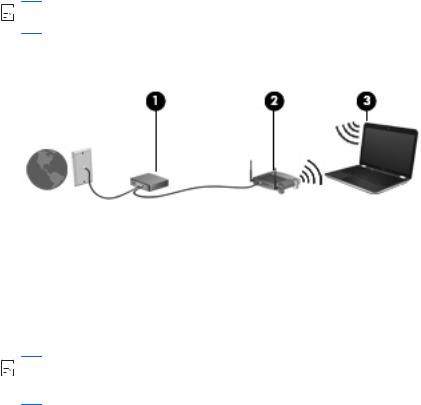
Setting up a WLAN
To set up a WLAN and connect to the Internet, you need the following equipment:
●A broadband modem (either DSL or cable) (1) and high-speed Internet service purchased from an Internet service provider
●A wireless router (2) (purchased separately)
●A wireless computer (3)


 NOTE: Some modems have a built-in wireless router. Check with your ISP to determine what type of modem you have.
NOTE: Some modems have a built-in wireless router. Check with your ISP to determine what type of modem you have.
The illustration below shows an example of a wireless network installation that is connected to the Internet.
As your network grows, additional wireless and wired computers can be connected to the network to access the Internet.
For help in setting up your WLAN, see the information provided by your router manufacturer or your ISP.
Configuring a wireless router
For help in setting up a WLAN, see the information provided by your router manufacturer or your ISP.


 NOTE: It is recommended that you initially connect your new wireless computer to the router by using the network cable provided with the router. When the computer successfully connects to the Internet, disconnect the cable, and access the Internet through your wireless network.
NOTE: It is recommended that you initially connect your new wireless computer to the router by using the network cable provided with the router. When the computer successfully connects to the Internet, disconnect the cable, and access the Internet through your wireless network.
Protecting your WLAN
When you set up a WLAN or access an existing WLAN, always enable security features to protect your network from unauthorized access. WLANs in public areas (hotspots) like coffee shops and airports may not provide any security. If you are concerned about the security of your computer when connected to a hotspot, limit your network activities to email that is not confidential and basic Internet surfing.
Wireless radio signals travel outside the network, so other WLAN devices can pick up unprotected signals. Take the following precautions to protect your WLAN:
●Use a firewall.
A firewall checks both data and requests for data that are sent to your network, and discards any suspicious items. Firewalls are available in both software and hardware. Some networks use a combination of both types.
●Use wireless encryption.
Connecting to a wireless network 19

Wireless encryption uses security settings to encrypt and decrypt data that is transmitted over the network. For more information, from the Start screen, type h, and then select Help and Support from the list of apps.
Connecting to a WLAN
To connect to the WLAN, follow these steps:
1.Be sure that the WLAN device is on. If the device is on, the wireless light is on. If the wireless light is off, press the wireless button.
 NOTE: On some models, the wireless light is amber when all wireless devices are off.
NOTE: On some models, the wireless light is amber when all wireless devices are off.
2.From the Desktop, tap or click the network status icon in the notification area, at the far right of the taskbar.
3.Select your WLAN from the list.
4.Click Connect.
If the WLAN is a security-enabled WLAN, you are prompted to enter a security code. Type the code, and then click OK to complete the connection.
 NOTE: If no WLANs are listed, you may be out of range of a wireless router or access point.
NOTE: If no WLANs are listed, you may be out of range of a wireless router or access point.


 NOTE: If you do not see the WLAN you want to connect to, from the Desktop, right-click the network status icon, and then select Open Network and Sharing Center. Click Set up a new connection or network. A list of options is displayed, allowing you to manually search for and connect to a network or to create a new network connection.
NOTE: If you do not see the WLAN you want to connect to, from the Desktop, right-click the network status icon, and then select Open Network and Sharing Center. Click Set up a new connection or network. A list of options is displayed, allowing you to manually search for and connect to a network or to create a new network connection.
After the connection is made, place the mouse pointer over the network status icon in the notification area, at the far right of the taskbar, to verify the name and status of the connection.


 NOTE: The functional range (how far your wireless signals travel) depends on WLAN implementation, router manufacturer, and interference from other electronic devices or structural barriers such as walls and floors.
NOTE: The functional range (how far your wireless signals travel) depends on WLAN implementation, router manufacturer, and interference from other electronic devices or structural barriers such as walls and floors.
Using Bluetooth wireless devices (select models only)
A Bluetooth device provides short-range wireless communications that replace the physical cable connections that traditionally link electronic devices such as the following:
●Computers (desktop, notebook, PDA)
●Phones (cellular, cordless, smart phone)
●Imaging devices (printer, camera)
●Audio devices (headset, speakers)
●Mouse
Bluetooth devices provide peer-to-peer capability that allows you to set up a personal area network (PAN) of Bluetooth devices. For information about configuring and using Bluetooth devices, see the Bluetooth software Help.
20 Chapter 3 Connecting to a network
